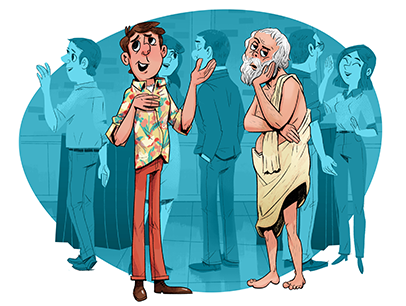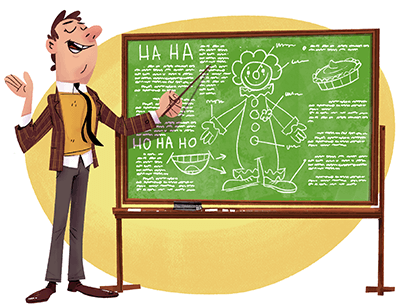 Illustration by Bart Browne
Illustration by Bart BrowneThe condemned man stands before a firing squad. The captain in charge offers him a final cigarette. The man replies, “No thanks, I’m trying to quit.”
This is gallows humor, a form of joking that deals with dire situations and grim subject matter in such a way as to make them more socially palatable. No one wants to hear that someone is “ill,” for instance. It’s too blunt. The word reveals a certain lack of consideration for the hypochondriacal among us who immediately jump from “ill” to “illness” to “serious illness” to “I hope he makes it.” Instead, we say the patient is “under the weather,” “not feeling up to par,” “not 100%,” “has some kind of bug,” or, if we really must be clinical, “down for the count.” Being a bit of a hypo myself, whenever I’m in mild respiratory distress I instruct my wife to refer to it as simply a “head cold,” or even more preferably, “the sniffles.” She is more than happy to comply, since the alternative would be for her to keep reassuring me that, no, I am not going to die, and yes, my will is up to date.
Freud jumps in here—as he seems to do whenever “grim” is the operative word—by theorizing that jokes of the dark humor variety are as revealing as dreams—an unconscious attempt to release psychic tension and to somehow get comfortable with a hopeless situation. It reminds me of the two men chained hand and foot to a dungeon wall, surrounded by concentric circles of (a) a moat with crocodiles, (b) a ring of fire, (c) a line of spiked fences, and (d) a pack of ravenous wolves … with one man saying to the other, “Now here’s my plan.”
Gallows humor gets its name, obviously, from the gallows, which has been employed throughout the ages to expedite one’s journey to the afterlife, usually involuntarily. The device reached its highest level of refinement with the Julian gallows, invented in 1892 by James Julian, an architect. Considering human safety is essential to good architectural design, I would love to know how Mr. Julian reconciled this requirement with the purpose for which his creation was intended.
When American comedian Bob Hope was asked where he wanted to be buried, he said, “Surprise me.”
Not surprisingly, the medical profession has a particular penchant for gallows humor, dealing as they so often do with the “ills that flesh is heir to.” (Thank you, Mr. Shakespeare.) A few years back I had a total hip replacement, which my doctor insensitively referred to as “major surgery.” (I would have much preferred “routine procedure.”) As I was about to be rendered unconscious, I remarked to the anesthesiologist that her job must require a great deal of training and a high level of skill. To which she replied, “I don’t get paid to put you to sleep. I get paid to wake you up.” Then she laughed. I didn’t.
People remembered for their words will make sure their final ones are no less impressive. When a priest asked Voltaire on his death bed to renounce Satan, the French philosopher replied, “This is no time to be making enemies.” And when Benjamin Franklin and his colonial colleagues committed treason by signing the Declaration of Independence, Franklin famously advised: “We must all hang together or, most assuredly, we will all hang separately.”
Humor being their stock in trade, comedians can always be counted on for some clever gallows whimsy, as when the American humorist Erma Bombeck wrote: “Seize the moment. Remember all those women on the Titanic who waved off the dessert cart.” And when another American comedian, Bob Hope, was asked where he wanted to be buried, he said, “Surprise me.”
My favorite example of irreverent jesting comes from a friend of mine with a devilishly mordant sense of humor. I was going through a particularly difficult time. It seemed that everything that could go wrong, did. Having coffee with him one morning, I mentioned how low I was feeling and he said, “Don’t worry—it’s always darkest just before it goes completely black.”
You might think that’s a horrible thing to say … but it made me laugh.
John Cadley is a former advertising copywriter, freelance writer, and musician living in Fayetteville, New York. Learn more at www.cadleys.com.



 Previous
Previous
 Previous Article
Previous Article

